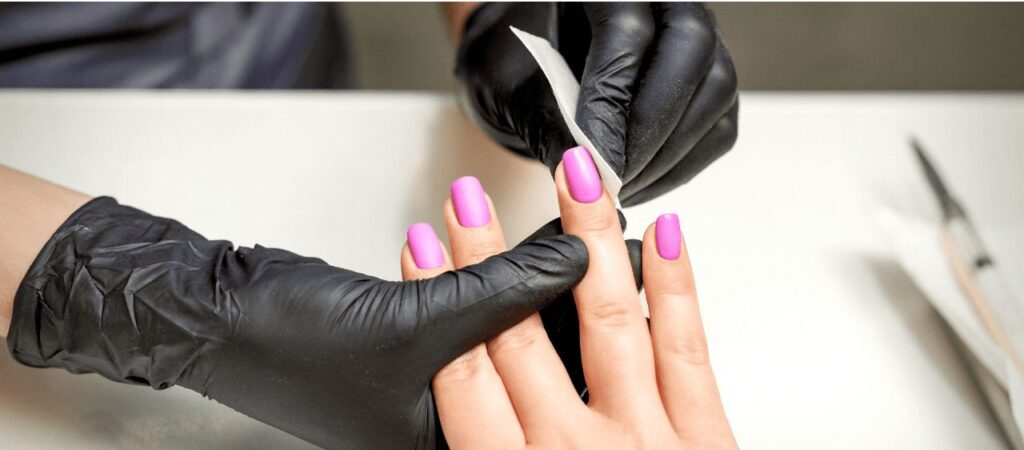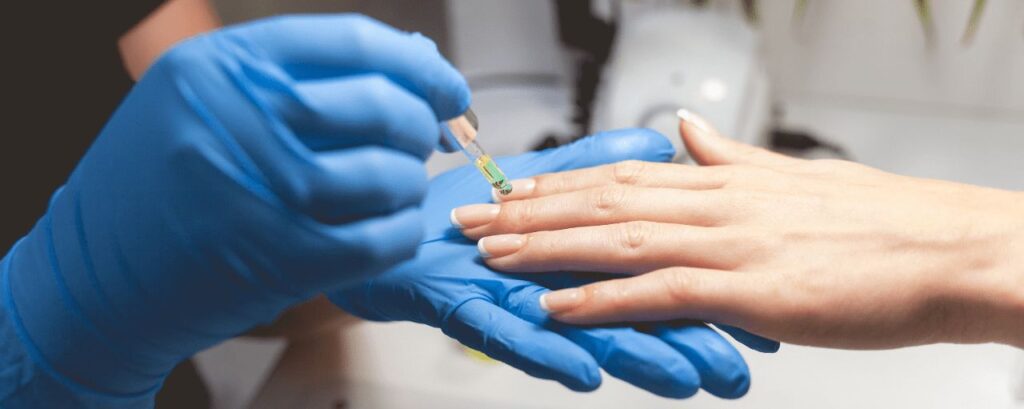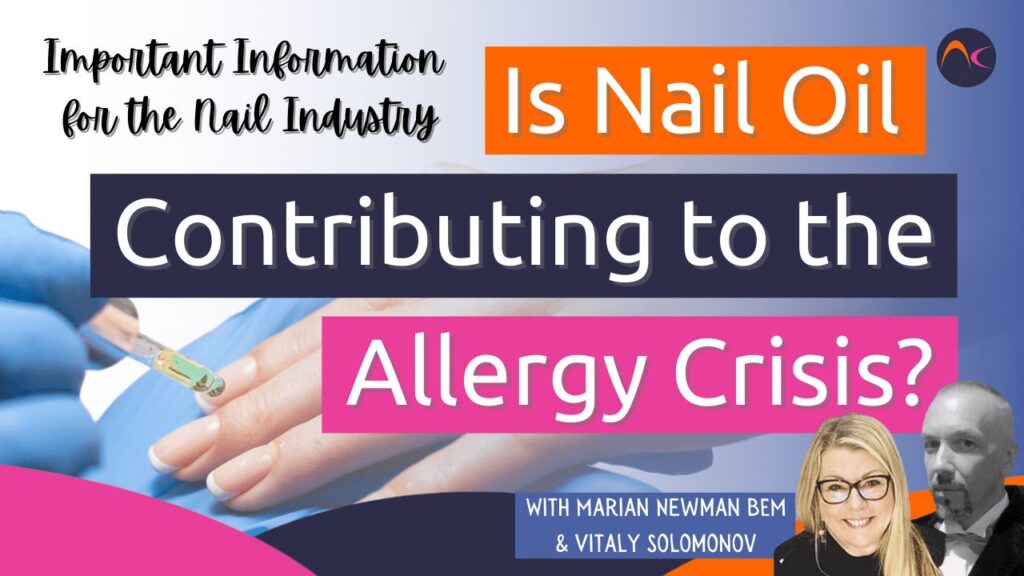We know about allergies. We know about sub-standard nail products. But this is very important information for the Nail Industry.
Some very recent research has just been published (August 2021 in The Journal of Allergy and Clinical Immunology) has shown another issue that we MUST be aware of and take notice. There is a lot of information regarding skin moisturisers in beauty products, but this article is just concerned with how us, as nail professionals, are affected.
My friend and colleague, Vitaly Solomonov, dermatologist and expert for NailKnowledge has also provided some more science and the references to support this information – Highlighted Blue.
There are three studies that have been published and more are underway.
What has been shown is that many ‘natural oils’ are harmful to the skin and disrupt the skin barrier.
The most relevant cause for concern in nail services is regarding UV gel top coats. Both traditional and ‘tack-free’.

EVERY nail professional, surely, must know that the sticky layer remaining after curing is unreacted product? But how many take the time and have the understanding that this must NOT touch the skin during the final cleansing?
There are 2 methods of doing this safely:
- Soak a pad in the recommended cleanser (which is usually an alcohol such as IPA). Start at the little finger and wipe the nail from base to free edge and NOT backwards nor side to side. Move onto the larger nails so the product on the pad is not touching the skin.
- Even safer, is to use a new soaked pad for each nail.
How many times do you see that pad rubbed all over the nail and therefore the skin and the same area of pad used for each nail? This is depositing uncured product on all the surrounding skin!
Tack-free top coats: they may not feel sticky and some use them to save time by not doing the final cleansing step. BUT they still have some uncured product on the surface. They MUST be cleansed!
What is the most common step after this? Oil! Massaging it in all around the nail and skin.

So, here is the problem! Uncured product is on the skin, oil is applied.
What the studies have shown is that the oil can act as ‘penetration enhancers’. This means that they are encouraging the penetration of allergens (placed onto the skin during the service) directly into the living cells of the skin!
From Vitaly:
First, let me summarise the results of recent studies that Marian has mentioned above. Those works have brought truly breakthrough news and may have an impact for several industries including the nail industry from several standpoints. Here is the most important conclusion amongst others we can make upon the studies:
It has been shown that the moisturisers (lotions and oils) that are widely used in baby skin care led to development of food allergy, atopic dermatitis and even asthma in the future life of an infant if they used frequently.
This sounds too scary, doesn’t it? However, let’s get started to sort things out to understand what is going on.
The phenomenon that mentioned in the first notion occurs because oils, especially those natural oils like olive, sunflower and many others may partly disrupt the skin barriers and potentiate the permeation of many compounds including allergens. The oils or lipid compounds can dissolve the allergenic substances and make them available to the immune cells in our skin. For instance, the trace neglectable amounts of milk shakes or mixtures for infants can be left on a baby’s skin after the contact with parents’ hands. Then, when we apply the moisturiser, its lipid components encourage the penetration of them into the baby’s skin. If the immune cells recognize the food components to be allergic, the reaction begins, and allergy develops immediately or many years after when a kid becomes an adult. That is why, one of the authors openly declare the following motto: “Olive oil is for food, not for skin care”, despite the current fashion for so called ‘natural’ or ‘organic’ products.
The data can be logically applied for our salon services because a nail technician often deal with potentially allergic substances such as uncured gels or ‘tacky residue’. Thus, the tacky residue being mixed with the oily components of the cosmetic products and easily penetrate the skin. It is important to note, that the components of nail products are not allergens itself. True allergens are always proteins. The components of UV gels, nail polishes or acrylics are not proteins. Now you can ask – Why are they considered to be potential allergens then? The key word here is ‘potential’. These substances that can be potentially harmful for your skin have their own name – let me introduce them – haptens. Haptens are substances of different chemical classes. They usually have a small molecular mass and can penetrate the skin barriers. They are not considered as allergens unless they come into reaction with our own proteins that are found in our skin. In this case they form the compound that become an allergen for us. Most of haptens are ‘oil loving’ molecules, which means that they can be dissolved in oils, which in turn helps them to penetrate the skin where they meet the lipid bilayers of our own Stratum Corneum and mix with them too.
Good news is that our skin is not a static structure or just a container that contains some mixtures. It has its structure, and the structure defines the health of our skin. The skin’s major responsibility is to protect us, and it means that all the skin structures do their best to prevent the permeation of almost all the outer substances, even those that are considered as ‘good for us’. Moreover, the human’s skin is ever changing organ and it strives to free our body from harmful or unnecessary substances by pushing out old layers and cells. The latter are just removed from the surface of the skin. It helps to ‘clean up’ the space.
On the other hand, we have to learn that cosmetic products may have an impact on very important structures in the stratum corneum. The most important part of those structures is lipids/water ratio (and water retaining substances, which are known as the natural moisturising factor). These two components create the optimal consistency of our skin, where the essential lipids are a key factor since they create the compact barrier. When it becomes too thick the skin is getting scaly and dry. When those lipids become too liquid, the skin becomes too prone to inflammation due to the partially disrupted barriers.
What is important for us and our work?
1) The frequent use of moisturisers can be harmful. Then the next question – what is ‘frequent’ use? The answer to the question – use your moisturiser 1-2 times a day. If you have symptoms of xerotic skin, use the special lotions and as professionals don’t blindly follow the marketing claims. Read the list of ingredients.
2) Oils. It is obvious, that we use the cuticle oils to prevent water evaporation from the area that we worked on, because some procedures (especially those that are well known as harmful – abrasions, solvents, peelings, etc. lead to water loss and dryness). Dryness is a first signal of disrupted skin barriers and the first step of possible skin inflammation). Always use the cuticle oils after you wash your hands with a soap or liquid soap.
3) When your service is done and the next perfect set of beautiful nails is created, ask you client to wash her/his hands with a soap before you apply a lotion, cream, or any other moisturiser to avoid the potential allergy outbreak.
4) If you work with a ‘tacky layer’, thoroughly remove it out first with acetone or isopropyl alcohol and then always wash with a soap before your next step in service.
5) Never touch skin with a product and keep your brush and other utensils clean even if you work in gloves.
6) If you feel that your regular moisturiser causes some dryness, change it with some more advanced formula and ingredients.
7) Avoid products with a huge load of essential oils, fragrances, and colorants – it will help to avoid allergy outbreak.
8) Avoid products that are advertised as ‘natural’ – that doesn’t mean they are safer. Often, most of them are considered as more allergenic, especially for the vulnerable skin types. Studies confirm this notion.
Yet another additional cause of allergy outbreaks for our industry!
Oil is a ‘non-negotiable’ addition to every nail service and home care so this step cannot be avoided. But adding an issue to a potential allergy is 100% avoidable!
Understand your products, understand the science. Work safely and minimise any harm that you may be causing to your clients and yourself!


